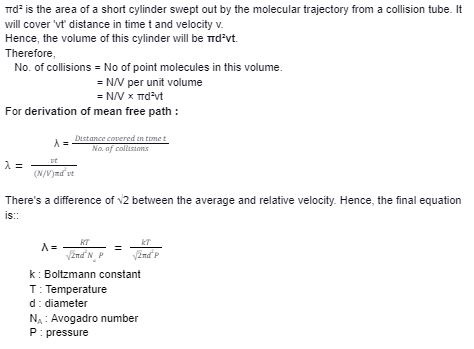In collisions between two or more objects, the average distance an object has to move is called the mean free path. The actual distance that the object moves is simply called free path because to calculate the mean free path, we would require the distance travelled by each particle/object in that particular region.
The probability that a molecule could move a certain distance between two points is dP. The probability dP is directly proportional to an exponential factor, i.e. dP = e-x/μdx (Here, e is the natural log base, μ is the mean free path.
Derivation of the mean free path
To derive the equation of mean free path, we need to make a few assumptions :
- The molecule is spherical
- Collision will take place when one molecule hits another.
- Moving molecules are considered. Other molecules are at rest with respect to the moving molecule.
- d is the diameter of a single molecule
- Single molecules will move via the gas

Factors affecting the mean free path
The factors on which the mean free path depends are:-
- Diameter of a molecule (inversely proportional to the square of diameter)
- Number of gas molecules per unit. (inversely proportional to number of gas molecules)
- Indirectly depends on factors like temperature( directly proportional), pressure (inversely proportional) and Boltzmann constant.
- When density increases, it causes more collisions, resulting in a decrease in the mean free path.
Specific mean free path:
The mean free path that is independent of density is called a specific mean free path. This doesn’t change with the change of density with respect to time.
The unit of specific mean free path is g/cm²
To obtain the actual mean free path, the specific mean free path can be divided by the density.
Use of Mean Free Path in different fields :
Radiography :
In gamma-radiography, the mean free path of a pencil beam of mono-energetic photons is the average distance a photon travels between collisions with the atoms of the target material.
In X-ray radiography, the photons are not mono-energetic, and hence, the calculation of the mean free path becomes very complex. However, the photons follow a spectrum of distribution of energies and hence, when they move through the target material, they are attenuated with probabilities with respect to their energies. This results in the hardening of the spectrum because of which the mean free path of the spectrum changes with distance.
Electronics :
The mean free path of a charge carrier in a metal L is proportional to the electric mobility. The thickness of a thin film can be lesser than the mean free path, making surface scattering much more noticeable and increasing resistivity.
Acoustics:
The relation for the mean free path of a single particle that bounces off the walls helps in the derivation of the Sabine equation in acoustics. The derivation uses the geometrical approximation of sound propagation.
In Nuclear and Particle Physics:
In nuclear and particle physics, the concept of mean free path is replaced by the concept of attenuation length. For high-energy photons interacting by electron-positron pair production, the concept of radiation length is used in place of the concept of mean free path.
- In transverse processes like viscosity, heat conduction, diffusion and electrical conduction, the process of calculations requires the use of the concept of mean free path.
- In many cases, particles whose motion and interaction conform to the laws of quantum mechanics, the concept of mean free path is used in calculations. In such cases, the calculations with the mean free path become extremely complex.
Important points to remember
- The free path between two successive collisions is a straight line with constant velocity as until collisions.
- After collision, they follow zigzag trajectories of different lengths. These zigzag trajectories are called molecular free paths, and the average of their varying length is referred to as mean free path.
- This zigzag trajectory is an example of diffusive motion (diffusion) or can also be compared with a random walk.
- The momentum and energy remain constant in these collisions, and hence ideal gas laws are always valid.
- There’s a need to quantify the mean free path since its measurement and the characterisation of randomly moving gas molecules are very different.
- The more collisions there are, the less is the mean free path.
Conclusion
When the particles pass through any material, they may start moving in different directions due to the collisions that take place in between them. The average distance between the particles after collision is known as the mean free path, which depends on factors like pressure, volume, temperature, density, etc. It also depends on the type of cross-section used in the calculations, i.e. scattering cross-sections or total cross-sections. It also depends upon the energy distribution of the particles with respect to the medium.
 Profile
Profile Settings
Settings Refer your friends
Refer your friends Sign out
Sign out




